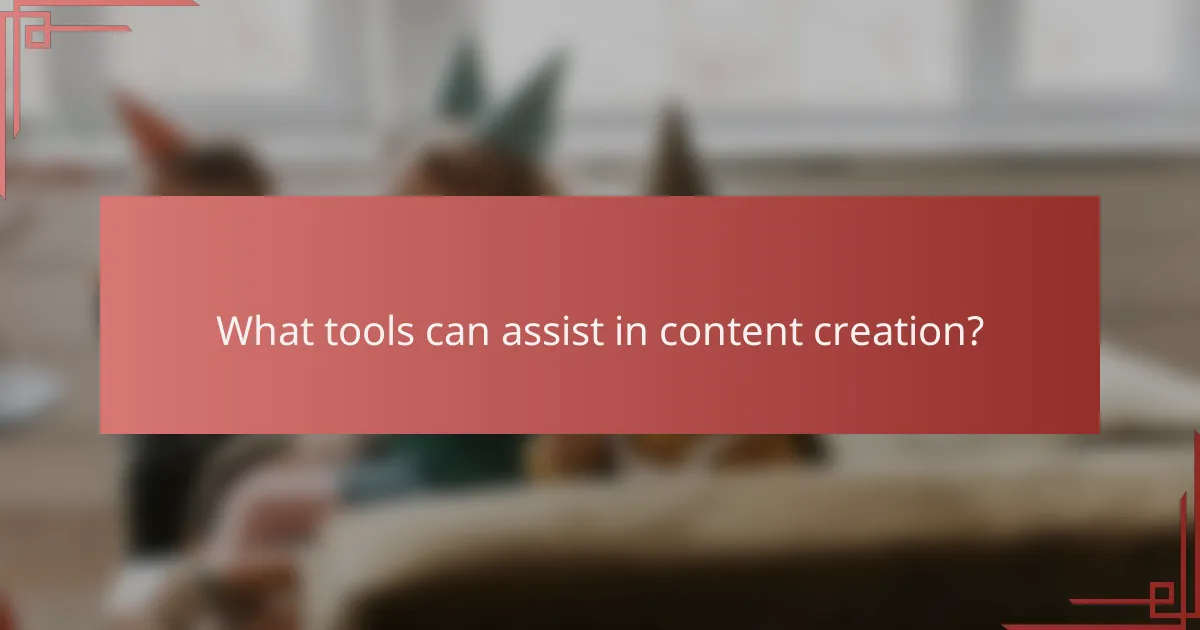Effective content creation hinges on the art of storytelling, which captivates audiences and fosters emotional connections. By integrating compelling narratives and striking visuals, creators can enhance engagement and comprehension, making their messages more memorable. Additionally, measuring audience interaction through various metrics offers valuable insights into the effectiveness of the content and its resonance with viewers.

How can storytelling enhance content creation?
Storytelling can significantly enhance content creation by making it more engaging and memorable. By weaving narratives into your content, you can capture attention, evoke emotions, and foster a deeper connection with your audience.
Emotional connection through narratives
Emotional connections are vital for effective storytelling. When content resonates on a personal level, it can lead to increased empathy and understanding among audiences. For instance, sharing a personal experience or a customer success story can evoke feelings that drive engagement.
To create emotional connections, consider using vivid imagery and relatable situations. Aim to highlight struggles and triumphs that your audience may face, making your content more impactful and relevant.
Building brand identity with stories
Stories play a crucial role in establishing and reinforcing brand identity. By consistently sharing narratives that reflect your brand’s values and mission, you can create a cohesive image that resonates with your target audience. This approach helps differentiate your brand in a crowded market.
For example, brands like Nike and Apple use storytelling to convey their commitment to innovation and empowerment. Crafting a unique brand story can enhance loyalty and encourage customers to identify with your brand on a deeper level.
Engaging audiences with relatable characters
Relatable characters are essential for engaging storytelling. They serve as a mirror for the audience, allowing them to see themselves in the narrative. This connection can lead to increased interest and investment in the content.
When creating characters, focus on traits and experiences that your audience can identify with. Use diverse perspectives to broaden your reach and ensure that different segments of your audience feel represented and engaged.

What role do visuals play in content engagement?
Visuals significantly enhance content engagement by capturing attention and aiding comprehension. They can simplify complex information, making it easier for audiences to retain and recall key messages.
Enhancing retention with infographics
Infographics combine text and visuals to present information in a digestible format, improving retention rates. They can effectively summarize data, making it easier for viewers to grasp trends and insights at a glance.
When creating infographics, focus on clarity and relevance. Use a balanced mix of images, icons, and concise text to convey your message. Aim for a design that is visually appealing but not overwhelming.
Using videos to boost interaction
Videos are powerful tools for increasing audience interaction, as they engage multiple senses and can convey emotions effectively. Short, engaging videos can keep viewers’ attention longer than text alone, fostering a deeper connection with the content.
Consider incorporating calls to action within your videos to encourage viewer participation. Keep videos concise, ideally under two minutes, to maintain interest and ensure that your message is delivered efficiently.
Creating shareable images for social media
Shareable images are essential for social media engagement, as they can quickly capture attention and encourage sharing among users. High-quality visuals that resonate with your audience can significantly increase the likelihood of your content being shared.
To create shareable images, focus on bold colors, clear messaging, and relevant themes that align with your brand. Tools like Canva or Adobe Spark can help you design eye-catching graphics that are optimized for various social media platforms.

How to measure engagement in content?
Measuring engagement in content involves analyzing how audiences interact with your material. Key metrics include click-through rates, social media shares, and audience feedback, all of which provide insights into content effectiveness and audience interest.
Analyzing click-through rates
Click-through rates (CTR) indicate the percentage of users who click on a link compared to the total number of users who view the content. A higher CTR suggests that your content is compelling and relevant to your audience. Aim for a CTR of around 2-5% as a general benchmark, although this can vary by industry.
To analyze CTR effectively, use tools like Google Analytics or social media insights. These platforms can help you track which headlines or calls to action perform best, allowing you to refine your approach. Regularly reviewing these metrics can help you identify trends and optimize future content.
Tracking social media shares
Social media shares reflect how often your content is shared across platforms, serving as a direct measure of its appeal. High share counts can enhance visibility and credibility, leading to increased traffic. Aim to monitor shares on major platforms like Facebook, Twitter, and LinkedIn to get a comprehensive view of engagement.
Utilize social media analytics tools to track shares and engagement metrics. Consider creating shareable content, such as infographics or videos, which often perform better than text-based posts. Engaging with your audience through comments and discussions can also encourage more shares.
Utilizing audience feedback and surveys
Audience feedback and surveys provide qualitative insights into how your content resonates with viewers. Collecting this information can help you understand preferences, pain points, and areas for improvement. Tools like Google Forms or SurveyMonkey can facilitate easy feedback collection.
When designing surveys, keep questions concise and focused on specific aspects of your content. For example, ask about clarity, relevance, or emotional impact. Regularly reviewing feedback can help you adapt your content strategy to better meet audience needs and enhance overall engagement.

What are the best practices for content creation?
The best practices for content creation focus on delivering high-quality, engaging material consistently across various platforms. Key elements include maintaining a regular posting schedule, optimizing content for search engines, and tailoring messages to fit different audiences and formats.
Consistency in posting schedules
Establishing a consistent posting schedule is crucial for audience engagement and retention. Regular updates keep your audience informed and encourage them to return for more content. Aim for a frequency that is manageable, such as weekly or bi-weekly, depending on your resources and audience expectations.
Consider using a content calendar to plan and track your posts. This tool helps ensure that you cover a variety of topics and maintain a steady flow of content. Avoid long gaps between posts, as this can lead to decreased audience interest.
Optimizing for SEO with keywords
Search engine optimization (SEO) is essential for increasing the visibility of your content. Incorporating relevant keywords naturally into your text helps search engines understand your content and rank it higher in search results. Research keywords that are popular within your niche and include them in titles, headings, and body text.
In addition to keywords, focus on creating high-quality content that answers users’ questions. Aim for a keyword density of around 1-2% to avoid keyword stuffing, which can negatively impact your rankings. Tools like Google Keyword Planner or SEMrush can assist in identifying effective keywords.
Adapting content for different platforms
Each platform has its unique audience and content requirements, making adaptation essential. For example, Instagram favors visually appealing images and short captions, while LinkedIn is better suited for professional articles and in-depth discussions. Tailor your content to fit the style and preferences of each platform.
Consider the format as well; videos may perform better on platforms like TikTok, while detailed blog posts work well on websites. Use analytics to track performance across platforms and adjust your strategy based on what resonates with your audience. This approach ensures that your content remains relevant and engaging, regardless of where it is published.

What tools can assist in content creation?
Several tools can enhance content creation by streamlining processes, improving design, and facilitating research. Utilizing the right tools can significantly boost engagement and effectiveness in storytelling.
Canva for graphic design
Canva is a user-friendly graphic design tool that allows creators to produce professional-quality visuals without extensive design experience. It offers a wide range of templates for social media posts, presentations, and infographics, making it easy to customize designs to fit specific branding needs.
When using Canva, consider the dimensions and formats required for different platforms. For instance, Instagram posts typically require a square format, while Facebook cover photos need a rectangular layout. Always check the latest guidelines to ensure your designs are optimized for each platform.
BuzzSumo for content research
BuzzSumo is a powerful tool for content research that helps identify trending topics and popular articles within specific niches. By analyzing social media shares and engagement metrics, it provides insights into what resonates with audiences, guiding content strategy effectively.
To maximize BuzzSumo’s potential, use its filtering options to narrow down results by date, content type, or platform. This allows you to focus on recent trends or specific formats, such as videos or infographics, which can inform your content creation process.
Hootsuite for social media management
Hootsuite is a comprehensive social media management platform that enables users to schedule posts, monitor engagement, and analyze performance across multiple networks. This tool is essential for maintaining a consistent online presence and engaging with audiences effectively.
When using Hootsuite, take advantage of its analytics features to track which posts perform best. Regularly review these insights to refine your content strategy and improve engagement rates. Additionally, consider setting up streams to monitor brand mentions and relevant conversations in real-time.



